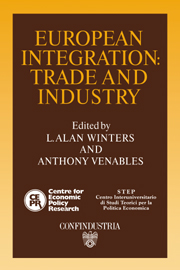Book contents
- Frontmatter
- Contents
- List of figures
- List of tables
- Preface
- Acknowledgements
- List of conference participants
- 1 European integration: trade and industry
- 2 Completing the internal market in the EC: factor demands and comparative advantage
- Discussion
- 3 External effects and Europe's integration
- Discussion
- 4 The quality and production of textiles and clothing and the completion of the internal market
- Discussion
- 5 Competition and imports in the European market
- Discussion
- 6 The structure and determinants of East–West trade: a preliminary analysis of the manufacturing sector
- Discussion
- 7 1992 and EFTA
- Discussion
- 8 Technology policy in the completed European market
- Discussion
- 9 Corporation tax, foreign direct investment and the single market
- Discussion
- 10 Japanese direct manufacturing investment in Europe
- Discussion
- Index
Discussion
Published online by Cambridge University Press: 07 September 2010
- Frontmatter
- Contents
- List of figures
- List of tables
- Preface
- Acknowledgements
- List of conference participants
- 1 European integration: trade and industry
- 2 Completing the internal market in the EC: factor demands and comparative advantage
- Discussion
- 3 External effects and Europe's integration
- Discussion
- 4 The quality and production of textiles and clothing and the completion of the internal market
- Discussion
- 5 Competition and imports in the European market
- Discussion
- 6 The structure and determinants of East–West trade: a preliminary analysis of the manufacturing sector
- Discussion
- 7 1992 and EFTA
- Discussion
- 8 Technology policy in the completed European market
- Discussion
- 9 Corporation tax, foreign direct investment and the single market
- Discussion
- 10 Japanese direct manufacturing investment in Europe
- Discussion
- Index
Summary
The authors' earlier work (C & L, 1989, 1990, 1990b) reports a successful search for evidence of external economies. In this study they report on an extension of that search in a new direction. The direction is an important one, as we know from the analytical work of Paul Krugman and Bill Ethier that the policy implications of international externalities can be quite different from those of national externalities. The fact that the present search has been essentially unsuccessful should not discourage further work on the issue.
The objective is to look for evidence that output growth in industry i in country j is influenced by growth in ‘world’ output of industry i, as well as by the effect of the growth of aggregate output in country j on which the earlier work focussed. The evidence for the intra-industry effect is provided by the fact that there is a slightly different relationship between input growth and output growth at the aggregate level (the reduced form coefficient of 1.36 or 1.46 in Table 3.3) than at the country level (the coefficient 1.23 or 1.14). Unfortunately, the difference is not statistically significant, indeed none of the reduced form coefficients in Table 3.3 is significantly different from 1, so we cannot reject the hypothesis that there are no external effects of any kind and that there are constant returns in production. If one were to take the positive intra-industry effect seriously in spite of the lack of statistical significance, I think that one would want to look more closely at the data for the source of the result.
- Type
- Chapter
- Information
- European IntegrationTrade and Industry, pp. 51 - 53Publisher: Cambridge University PressPrint publication year: 1991
- 1
- Cited by



